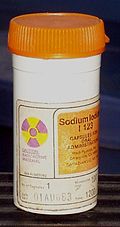Radiopharmacology
| Radiopharmacology | |
|---|---|
 Lead container for iodine-123 capsule | |
| Other names | Medicinal radiochemistry |
| Specialty | oncology |
Radiopharmacology is
tumors.[1]
The term radioisotope, which in its general
radioiodine
) are used directly as soluble ionic salts, without further modification. This use relies on the chemical and biological properties of the radioisotope itself, to localize it within the body.
History
See nuclear medicine.
Production
Production of a radiopharmaceutical involves two processes:
- The production of the radionuclide on which the pharmaceutical is based.
- The preparation and packaging of the complete radiopharmaceutical.
Radionuclides used in radiopharmaceuticals are mostly radioactive
isotopes of elements with atomic numbers less than that of bismuth
, that is, they are radioactive isotopes of elements that also have one or more stable isotopes. These may be roughly divided into two classes:
- Those with more neutrons in the nucleus than those required for stability are known as proton-deficient, and tend to be most easily produced in a radioisotopes.[2]
- Those with fewer neutrons in the nucleus than those required for stability are known as neutron-deficient, and tend to be most easily produced using a proton accelerator such as a medical cyclotron.[3]
Practical use
Because radiopharmeuticals require special licenses and handling techniques, they are often kept in local centers for medical radioisotope storage, often known as
radiopharmacies. A radiopharmacist may dispense them from there, to local centers where they are handled at the practical medicine
facility.
Drug nomenclature for radiopharmaceuticals
As with other pharmaceutical drugs, there is
International Nonproprietary Name (INN) gives the base drug name, followed by the radioisotope (as mass number, no space, element symbol) in parentheses with no superscript, followed by the ligand (if any). It is common to see square brackets and superscript superimposed onto the INN name, because chemical nomenclature (such as IUPAC nomenclature) uses those. The United States Pharmacopeia (USP) name gives the base drug name, followed by the radioisotope (as element symbol, space, mass number) with no parentheses, no hyphen, and no superscript, followed by the ligand (if any). The USP style is not the INN style, despite their being described as one and the same in some publications (e.g., AMA,[4] whose style for radiopharmaceuticals matches the USP style). The United States Pharmacopeial Convention is a sponsor organization of the USAN Council, and the USAN
for a given drug is often the same as the USP name.
International Nonproprietary Name (INN) |
United States Pharmacopeia (USP) | Comments |
|---|---|---|
| technetium (99mTc) sestamibi | technetium Tc 99m sestamibi | |
fludeoxyglucose (18F) |
fludeoxyglucose F 18 | |
| sodium iodide (125I) | sodium iodide I 125 | |
| indium (111In) altumomab pentetate | indium In 111 altumomab pentetate |
See also
References
- ISBN 3-527-29496-1
- ^ "Canada's Chalk River Reactor coming back online will not solve long-term isotope shortage in hospitals, researchers say".
- ^ "Archived copy" (PDF). Archived from the original (PDF) on 2018-03-13. Retrieved 2014-09-21.
{{cite web}}: CS1 maint: archived copy as title (link) - ISBN 978-0-19-517633-9.)
{{citation}}:|first=has generic name (help)CS1 maint: multiple names: authors list (link
Further reading
- Notes for guidance on the clinical administration of radiopharmaceuticals and use of sealed radioactive sources. Administration of radioactive substances advisory committee. March 2006. Produced by the Health Protection Agency.
- Malabsorption. In: The Merck Manual of Geriatrics, chapter 111.
- Leukoscan summary of product characteristics (Tc99m-Sulesomab).
- Schwochau, Klaus. Technetium. Wiley-VCH (2000). ISBN 3-527-29496-1
External links
- National Isotope Development Center U.S. Government resources for isotopes - production, distribution, and information
- Isotope Development & Production for Research and Applications (IDPRA) U.S. Department of Energy program sponsoring isotope production and production research and development
